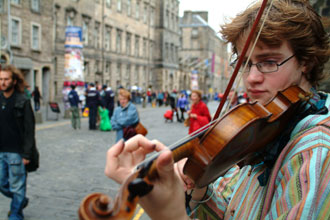 Bagpipes
Bagpipes
Though bagpipes are closely associated with Scotland and only Scotland by many outsiders, the instrument (or, more precisely, family of instruments) is found throughout large swathes of Europe, North Africa and South Asia. Out of the many varieties of Scottish bagpipes, the most common in modern days is the Highlands variety, which was spread through its use by the Highland regiments of the British Army.
The most traditional form of Highland bagpipe music is called pibroch, which consists of a theme (urlar) which is repeated, growing increasingly complex each time. The last, and most complex variation (cruunluath), gives way to a sudden and unadorned rendition of the theme.
Bagpipe competitions are now common in Scotland, with popular bands including colonial groups like the Victoria Police Pipe Band (Australia) and Canada's 78th Fraser Highlanders Pipe Band and the Simon Fraser University Pipe Band, as well as Scottish bands like Shotts and Dykehead Pipe Band and Strathclyde Police Pipe Band.
Fiddle
Scottish traditional fiddling encompasses a number of regional styles, including the bagpipe-inflected west Highlands, the upbeat and lively style of Norse-influenced Shetland Islands and the strathspeys and slow airs of the North-East. The instrument arrived late in the 17th century, and is first mentioned in 1680 in a document from Newbattle Abbey in Midlothian, Lessones For Ye Violin.
In the 18th century, Scottish fiddling is said to have reached new heights. Fiddlers like William Marshall and Niel Gow were legends across Scotland, and the first collections of fiddle tunes were published in midcentury. The most famous and useful of these collections was a series published by Nathaniel Gow, one of Niel's sons, and a fine fiddler and composer in his own right. Classical composers such as Charles McLean, James Oswald and William McGibbon used Scottish fiddling traditions in their Baroque compositions.
Guitar
The history of the guitar in traditional music is recent; equally so is that of the cittern and bouzouki, which in the forms used in Scottish and Irish music only date to the late 1960s. Notable artists include Tony McManus, Dave MacIsaac, and Dick Gaughan. Other notable guitarists in Scottish music scene include Kris Drever of Fine Friday and Lau, and Ross Martin of Cliar, Daimh and Harem Scarem.
Harp
The harp, or clarsach, has a long history in Scotland, rivalling even the bagpipes for the position as national instrument. Triangular harps were known as far back as the 10th century, when they appear on Pictish carvings, and harp compositions may have even formed the basis for pibroch, the folk bagpipe tradition. By the 18th century, however, the harp was no longer popular, and it was not revived until the 1890s. The 1931 formation of the Clarsach Society kickstarted the harp renaissance. Recent harp players include Savourna Stevenson, Maggie MacInnis, and the band Sileas.
Tin Whistle
One of the oldest tin whistles still in existance is the Tusculum whistle, found with pottery dating to the 14th and 15th centuries; it's currently in the collection of the Museum of Scotland. Today the whistle is a very common instrument in recorded Scottish music. Although few well-known performers choose the tin whistle as their principle istrument, it is quite common for pipers, flute players, and other musicians to play the whistle as well.
本频道更多精彩内容